Related Research Articles

Project Mercury was the first human spaceflight program of the United States, running from 1958 through 1963. An early highlight of the Space Race, its goal was to put a man into Earth orbit and return him safely, ideally before the Soviet Union. Taken over from the US Air Force by the newly created civilian space agency NASA, it conducted 20 uncrewed developmental flights, and six successful flights by astronauts. The program, which took its name from Roman mythology, cost $2.68 billion. The astronauts were collectively known as the "Mercury Seven", and each spacecraft was given a name ending with a "7" by its pilot.
Human spaceflight programs have been conducted, started, or planned by multiple countries and companies. Until the 21st century, human spaceflight programs were sponsored exclusively by governments, through either the military or civilian space agencies. With the launch of the privately funded SpaceShipOne in 2004, a new category of human spaceflight programs – commercial human spaceflight – arrived. By the end of 2022, three countries and one private company (SpaceX) had successfully launched humans to Earth orbit, and two private companies had launched humans on a suborbital trajectory.

Gemini 3 was the first crewed mission in NASA's Project Gemini and was the first time two American astronauts flew together into space. On March 23, 1965, astronauts Gus Grissom and John Young flew three low Earth orbits in their spacecraft, which they nicknamed Molly Brown. It was the first U.S. mission in which the crew fired thrusters to change the size and shape of their orbit, a key test of spacecraft maneuverability vital for planned flights to the Moon. It was also the final crewed flight controlled from Cape Kennedy Air Force Station in Florida, before mission control functions were moved to a new control center at the newly opened Manned Spacecraft Center in Houston, Texas.
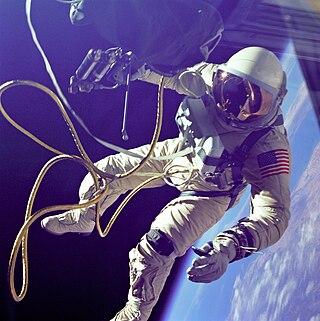
Gemini 4 was the second crewed spaceflight in NASA's Project Gemini, occurring in June 1965. It was the tenth crewed American spaceflight. Astronauts James McDivitt and Ed White circled the Earth 66 times in four days, making it the first US flight to approach the five-day flight of the Soviet Vostok 5. The highlight of the mission was the first space walk by an American, during which White floated free outside the spacecraft, tethered to it, for approximately 23 minutes.
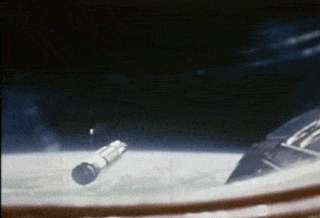
Gemini 8 was the sixth crewed spaceflight in NASA's Gemini program. It was launched on March 16, 1966, and was the 14th crewed American flight and the 22nd crewed spaceflight overall. The mission conducted the first docking of two spacecraft in orbit, but also suffered the first critical in-space system failure of a U.S. spacecraft which threatened the lives of the astronauts and required an immediate abort of the mission. The crew returned to Earth safely.

Gemini 9A was a 1966 crewed spaceflight in NASA's Gemini program. It was the seventh crewed Gemini flight, the 15th crewed American flight and the 23rd spaceflight of all time. The original crew for Gemini 9, command pilot Elliot See and pilot Charles Bassett, were killed in a crash on February 28, 1966, while flying a T-38 jet trainer to the McDonnell Aircraft plant in St. Louis, Missouri to inspect their spacecraft. Their deaths promoted the backup crew, Thomas P. Stafford and Eugene Cernan, to the prime crew. The mission was renamed Gemini 9A after the original May 17 launch was scrubbed when the mission's Agena Target Vehicle was destroyed after a launch failure. The mission was flown June 3–6, 1966, after launch of the backup Augmented Target Docking Adaptor (ATDA). Stafford and Cernan rendezvoused with the ATDA, but were unable to dock with it because the nose fairing had failed to eject from the docking target due to a launch preparation error. Cernan performed a two-hour extravehicular activity, during which it was planned for him to demonstrate free flight in a self-contained rocket pack, the USAF Astronaut Maneuvering Unit. He was unable to accomplish this due to stress, fatigue, and overheating.

Gemini 1 was the first mission in NASA's Gemini program. An uncrewed test flight of the Gemini spacecraft, its main objectives were to test the structural integrity of the new spacecraft and modified Titan II launch vehicle. It was also the first test of the new tracking and communication systems for the Gemini program and provided training for the ground support crews for the first crewed missions.

Gemini 2 was the second spaceflight of the American human spaceflight program Project Gemini, and was launched and recovered on January 19, 1965. Gemini 2, like Gemini 1, was an uncrewed mission intended as a test flight of the Gemini spacecraft. Unlike Gemini 1, which was placed into orbit, Gemini 2 made a suborbital flight, primarily intended to test the spacecraft's heat shield. It was launched on a Titan II GLV rocket. The spacecraft used for the Gemini 2 mission was later refurbished into the Gemini B configuration, and was subsequently launched on another suborbital flight, along with OPS 0855, as a test for the US Air Force Manned Orbital Laboratory. Gemini spacecraft no. 2 was the first craft to make more than one spaceflight since the X-15, and the only one until Space Shuttle Columbia flew its second mission in 1981; it would also be the only space capsule to be reused until Crew Dragon Endeavour was launched a second time in 2021.

The Boeing X-20 Dyna-Soar was a United States Air Force (USAF) program to develop a spaceplane that could be used for a variety of military missions, including aerial reconnaissance, bombing, space rescue, satellite maintenance, and as a space interceptor to sabotage enemy satellites. The program ran from October 24, 1957, to December 10, 1963, cost US$660 million, and was cancelled just after spacecraft construction had begun.

Robert Franklyn "Bob" Overmyer was an American test pilot, naval aviator, aeronautical engineer, physicist, United States Marine Corps officer, and USAF/NASA astronaut. Overmyer was selected by the Air Force as an astronaut for its Manned Orbiting Laboratory in 1966. Upon cancellation of the program in 1969, he became a NASA astronaut and served support crew duties for the Apollo program, Skylab program, and Apollo-Soyuz Test Project. In 1976, he was assigned to the Space Shuttle program and flew as pilot on STS-5 in 1982 and as commander on STS-51-B in 1985. He was selected as a lead investigator into the Space Shuttle Challenger disaster in 1986, retiring from NASA that same year. A decade later, Overmyer died while testing the Cirrus VK-30 homebuilt aircraft.

Donald Herod Peterson was a United States Air Force officer and NASA astronaut. Peterson was originally selected for the Air Force Manned Orbiting Laboratory (MOL) program, but, when that was canceled, he became a NASA astronaut in September 1969. He was a mission specialist on STS-6 on board Challenger. During the mission Peterson performed a spacewalk to test the new airlock and space suits. He logged 120 hours in space. Peterson retired from NASA in 1984.

The Manned Orbiting Laboratory (MOL) was part of the United States Air Force (USAF) human spaceflight program in the 1960s. The project was developed from early USAF concepts of crewed space stations as reconnaissance satellites, and was a successor to the canceled Boeing X-20 Dyna-Soar military reconnaissance space plane. Plans for the MOL evolved into a single-use laboratory, for which crews would be launched on 30-day missions, and return to Earth using a Gemini B spacecraft derived from NASA's Gemini spacecraft and launched with the laboratory.
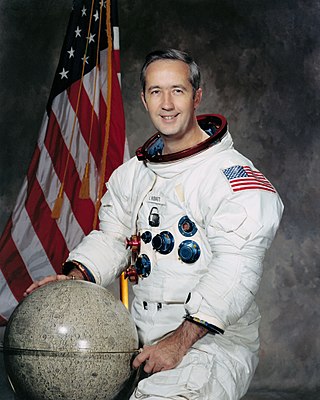
James Alton McDivitt Jr. was an American test pilot, United States Air Force (USAF) pilot, aeronautical engineer, and NASA astronaut in the Gemini and Apollo programs. He joined the USAF in 1951 and flew 145 combat missions in the Korean War. In 1959, after graduating first in his class with a Bachelor of Science degree in Aeronautical Engineering from the University of Michigan through the U.S. Air Force Institute of Technology (AFIT) program, he qualified as a test pilot at the Air Force Experimental Flight Test Pilot School and Aerospace Research Pilot School, and joined the Manned Spacecraft Operations Branch. By September 1962, McDivitt had logged over 2,500 flight hours, of which more than 2,000 hours were in jet aircraft. This included flying as a chase pilot for Robert M. White's North American X-15 flight on July 17, 1962, in which White reached an altitude of 59.5 miles (95.8 km) and became the first X-15 pilot to be awarded Astronaut Wings.

Project Gemini was the second United States human spaceflight program to fly. Conducted after the first American crewed space program, Project Mercury, while the Apollo program was still in early development, Gemini was conceived in 1961 and concluded in 1966. The Gemini spacecraft carried a two-astronaut crew. Ten Gemini crews and 16 individual astronauts flew low Earth orbit (LEO) missions during 1965 and 1966.
Man In Space Soonest (MISS) was a United States Air Force (USAF) program to put a man into outer space before the Soviet Union. The program was cancelled on August 1, 1958, and was replaced by NASA's Project Mercury. Only two men from the program would actually reach outer space. The first, Joseph A. Walker, did so two or three times in X-15 rocket plane tests in 1963. The other, Neil Armstrong, became a NASA astronaut in 1962, flew on Gemini 8 in 1966, and in 1969 on Apollo 11 becoming the first person to walk on the Moon.

NASA Astronaut Group 3 was a group of fourteen astronauts selected by NASA for the Gemini and Apollo program. Their selection was announced in October 1963. Seven were from the United States Air Force, four from the United States Navy, one was from the United States Marine Corps and two were civilians. Four died in training accidents before they could fly in space. All of the surviving ten flew Apollo missions; five also flew Gemini missions. Buzz Aldrin, Alan Bean, Gene Cernan and David Scott walked on the Moon.

NASA Astronaut Group 7 was a group of seven astronauts accepted by the National Aeronautics and Space Administration (NASA) on August 14, 1969. It was the last group to be selected during the Project Apollo era, and the first since the Mercury Seven in which all members were active-duty military personnel, and all made flights into space.
Advanced Gemini was a series of proposals that would have extended the Gemini program by the addition of various missions, including crewed low Earth orbit, circumlunar and lunar landing missions. Gemini was the second crewed spaceflight program operated by NASA, and consisted of a two-seat spacecraft capable of maneuvering in orbit, docking with uncrewed spacecraft such as Agena Target Vehicles, and allowing the crew to perform tethered extra-vehicular activities.
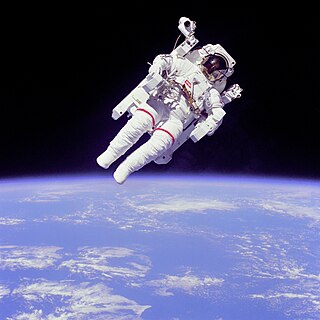
An astronaut propulsion unit is used to move an astronaut relative to the spaceship during a spacewalk. The first astronaut propulsion unit was the Hand-Held Maneuvering Unit (HHMU) used on Gemini 4.
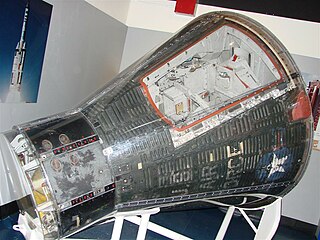
Gemini SC-2 was the second NASA Project Gemini full-up reentry capsule built. This McDonnell Gemini capsule was the first space capsule to be reused, flying twice in suborbital flights. SC-2 flew on Gemini 2 and OPS 0855 flights. The capsule is currently on display at the Air Force Space and Missile Museum at Cape Canaveral Air Force Station.
References
![]() This article incorporates public domain material from websites or documents of the National Aeronautics and Space Administration .
This article incorporates public domain material from websites or documents of the National Aeronautics and Space Administration .
- ↑ NASA/USAF Blue Gemini History Sole source reference.
- ↑ Outzen, J.D. The Dorian files revealed (PDF). pp. 5–9. ISBN 978-1-937219-18-5.
- ↑ NASA History Office on Blue Gemini Archived 2007-07-12 at the Wayback Machine
- ↑ Berger, Carl. "HISTORY OF THE MANNED ORBITING LABORATORY (MOL) PROGRAM" (PDF). NRO. p. 19.
- ↑ Gemini-B Spacecraft
